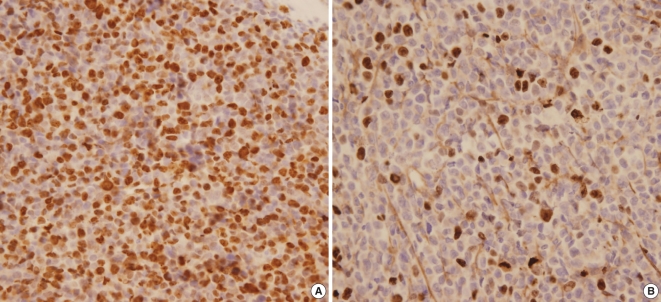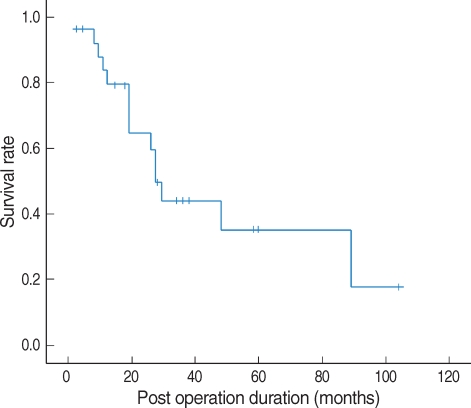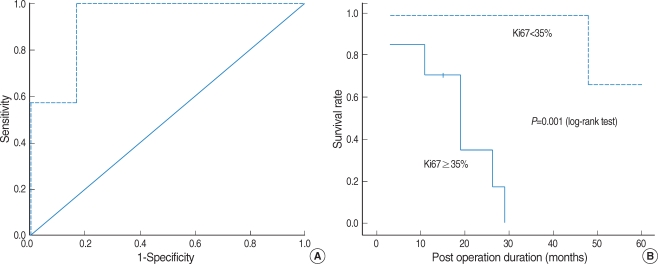Clin Exp Otorhinolaryngol.
2008 Dec;1(4):206-210.
Ki67 Antigen as a Predictive Factor for Prognosis of Sinonasal Mucosal Melanoma
- Affiliations
-
- 1Department of Otorhinolaryngology, College of Medical and Research Center for Sensory Organs, Medical Research Center, Seoul National University, Seoul, Korea. csrhee@snu.ac.kr
- 2Allergy & Clinical Immunology, Medical Research Center, Seoul National University, Seoul, Korea.
Abstract
OBJECTIVES
Sinonasal mucosal melanoma is a rare and aggressive disease. The aim of this study was to analyze the clinical features of patients with sinonasal mucosal melanoma and to determine the role of Ki67 antigen as a predictor of prognosis in sinonasal mucosal melanoma. METHODS: This was a retrospective case- series study at a single institution, an academic tertiary referral center. From 1995 to 2007, 27 patients with sinonasal mucosal melanoma were reviewed retrospectively, and the expression of Ki67 antigen was assessed by immunohistochemistry. RESULTS: The overall 5-yr survival rate was 33.9%. No significant differences were observed in 5-yr survival according to age, sex, stage, or the presence of melanin. The rates of local failure, regional failure, and distant failure were 37.0%, 14.8%, and 11.1%, respectively. Patients with spindle or mixed cell types had better prognoses than those with other cell types. At a cut-off value of 35%, patients with lower Ki67 scores showed better survival than those with higher Ki67 scores. CONCLUSION: The presence of spindle or mixed cell types may indicate a better prognosis than other cell types. Ki67 immunostaining may be a useful predictor of prognosis in patients with mucosal malignant melanoma of the sinonasal tract.
Keyword
MeSH Terms
Figure
Reference
-
1. Holdcraft J, Gallagher JC. Malignant melanomas of the nasal and paranasal sinus mucosa. Ann Otol Rhinol Laryngol. 1969; 2. 78(1):5–20. PMID: 5763191.2. Thompson LD, Wieneke JA, Miettinen M. Sinonasal tract and nasopharyngeal melanomas: a clinicopathologic study of 115 cases with a proposed staging system. Am J Surg Pathol. 2003; 5. 27(5):594–611. PMID: 12717245.
Article3. Freedman HM, DeSanto LW, Devine KD, Weiland LH. Malignant melanoma of the nasal cavity and paranasal sinuses. Arch Otolaryngol. 1973; 4. 97(4):322–325. PMID: 4699540.
Article4. Berthelsen A, Andersen AP, Jensen TS, Hansen HS. Melanomas of the mucosa in the oral cavity and the upper respiratory passages. Cancer. 1984; 9. 01. 54(5):907–912. PMID: 6744219.
Article5. Hong SL, Kim SW, Won TB, Shim WS, Kim YM, Kim JW, et al. Clinical features and treatment outcomes of mucosal malignant melanomas of nasal cavity and paranasal sinuses. Korean J Otolaryngol-Head Neck Surg. 2006; 12. 49(12):1176–1180.6. Patel SG, Prasad ML, Escrig M, Singh B, Shaha AR, Kraus DH, et al. Primary mucosal malignant melanoma of the head and neck. Head Neck. 2002; 3. 24(3):247–257. PMID: 11891956.
Article7. Shah JP, Huvos AG, Strong EW. Mucosal melanomas of the head and neck. Am J Surg. 1977; 10. 134(4):531–535. PMID: 911040.
Article8. Linden MD, Torres FX, Kubus J, Zarbo RJ. Clinical application of morphologic and immunocytochemical assessments of cell proliferation. Am J Clin Pathol. 1992; 5. 97(5 Suppl 1):S4–S13. PMID: 1575220.9. Cuevas E, Jones DB, Wright DH. Immunohistochemical detection of tumour growth fraction (Ki-67 antigen) in formalin-fixed and routinely processed tissues. J Pathol. 1993; 4. 169(4):477–478. PMID: 8501545.
Article10. Stern SJ, Guillamondegui OM. Mucosal melanoma of the head and neck. Head Neck. 1991; Jan–Feb. 13(1):22–27. PMID: 1989926.
Article11. Takagi M, Ishikawa G, Mori W. Primary malignant melanoma of the oral cavity in Japan. With special reference to mucosal melanosis. Cancer. 1974; 8. 34(2):358–370. PMID: 4853771.
Article12. Kingdom TT, Kaplan MJ. Mucosal melanoma of the nasal cavity and paranasal sinuses. Head Neck. 1995; May–Jun. 17(3):184–189. PMID: 7782202.
Article13. Chiu NT, Weinstock MA. Melanoma of oronasal mucosa. Population-based analysis of occurrence and mortality. Arch Otolaryngol Head Neck Surg. 1996; 9. 122(9):985–988. PMID: 8797564.
Article14. Manolidis S, Donald PJ. Malignant mucosal melanoma of the head and neck: review of the literature and report of 14 patients. Cancer. 1997; 10. 15. 80(8):1373–1386. PMID: 9338460.15. Batsakis JG, Regezi JA, Solomon AR, Rice DH. The pathology of head and neck tumors: mucosal melanomas, part 13. Head Neck Surg. 1982; May–Jun. 4(5):404–418. PMID: 7096100.
Article16. Prasad ML, Patel SG, Huvos AG, Shah JP, Busam KJ. Primary mucosal melanoma of the head and neck: a proposal for microstaging localized, Stage I (lymph node-negative) tumors. Cancer. 2004; 4. 15. 100(8):1657–1664. PMID: 15073854.17. Rinaldo A, Shaha AR, Patel SG, Ferlito A. Primary mucosal melanoma of the nasal cavity and paranasal sinuses. Acta Otolaryngol. 2001; 12. 121(8):979–982. PMID: 11813907.
Article
- Full Text Links
- Actions
-
Cited
- CITED
-
- Close
- Share
- Similar articles
-
- Concurrent Mucosal Melanoma and Angiofibroma of the Nose
- Primary sinonasal mucosal melanoma simulated as cystic lesions: a case report
- A Case of Labial Mucosal Melanoma Metastasized to the Lung
- Mucosal Melanoma of the Sinonasal Tract: Retrospective Analysis of 38 Patients of a Single Institution
- A Case of Amelanotic Malignant Melanoma Misconceived as Nasal Polyp




